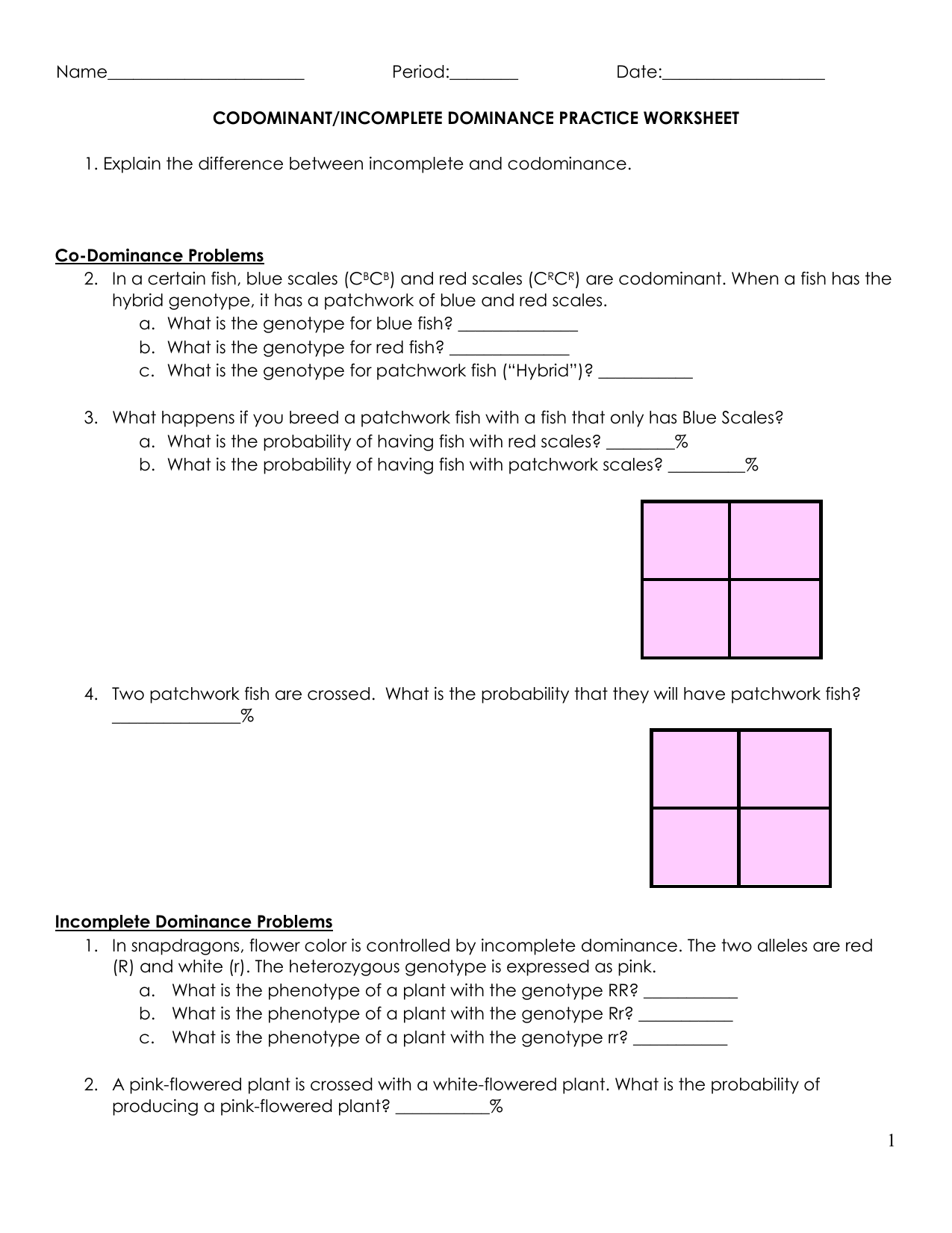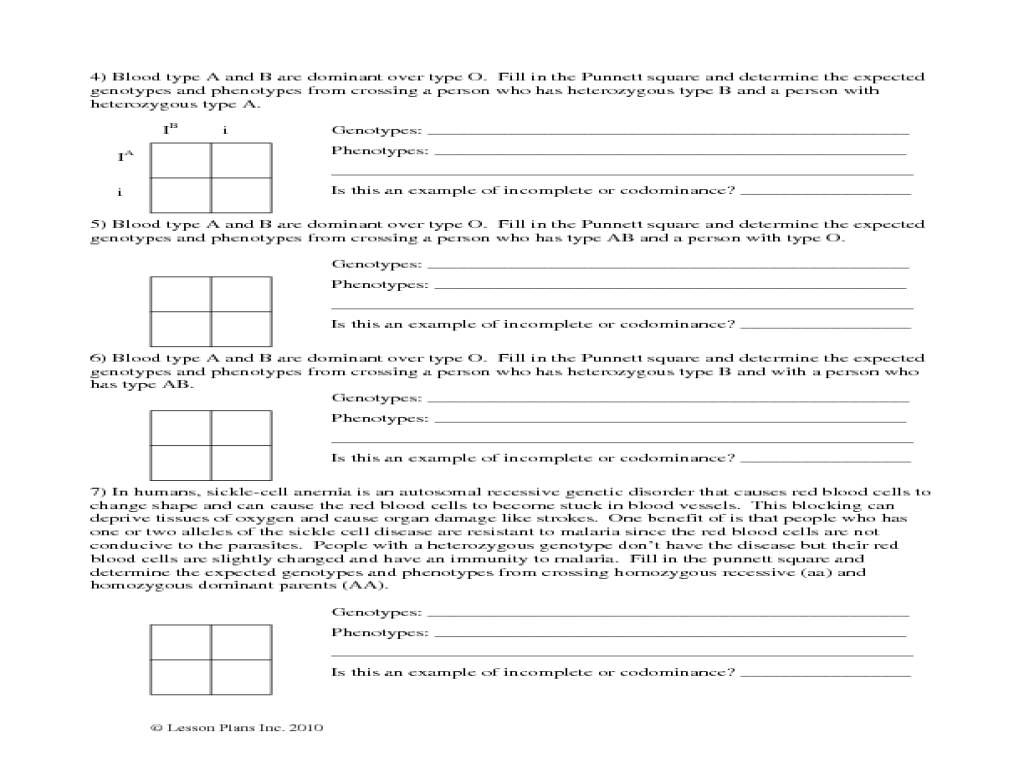Remember that time you were trying to explain to your friend how their dog could be spotted brown and white, while both its parents were solid brown? Or maybe it was the shocking news that their red-haired, freckled child had a brunette, freckle-free sibling! These are just a couple of examples where the basic concept of “one gene, one trait” falls short. In these cases, the inheritance patterns take a turn, going beyond the simple dominant and recessive relationships we were taught in high school biology. It’s time to delve into the exciting world of incomplete dominance and codominance, where genes can express themselves in more creative ways, leading to a kaleidoscope of phenotypes.

Image: studylib.net
Understanding these concepts is crucial for anyone studying genetics or simply curious about the wonderful diversity of life. Practice worksheets are a perfect tool to grasp these concepts, helping you unlock the secrets hidden within the genes and understand how these mechanisms shape the world around us. Let’s embark on this fascinating journey together, unraveling the intricacies of incomplete dominance and codominance, mastering the skills to solve practice worksheets and gaining a deeper understanding of genetic inheritance.
Diving Deep into Incomplete Dominance and Codominance
In the realm of genetics, we often encounter scenarios where the inheritance of traits doesn’t follow the traditional dominant-recessive pattern. Here’s where incomplete dominance and codominance come into play, introducing a more complex and exciting layer to the world of heredity. Let’s dive into these fascinating concepts, understand their differences, and learn their application.
Understanding Incomplete Dominance
Incomplete dominance occurs when neither allele for a trait is completely dominant over the other. This means that the heterozygous genotype will result in a phenotype that is a blend of the two parental phenotypes. A classic example is the snapdragon flower. When a red flower (CRCR) is crossed with a white flower (CWCW), the resulting F1 generation will all have pink flowers (CRCW). Here, the pink phenotype is a result of an intermediate expression of both red and white alleles. The heterozygote (CRCW) expresses a phenotype that is distinct from either homozygote (CRCR or CWCW).
Understanding Codominance
In codominance, both alleles are expressed equally in the phenotype. This means that the heterozygote will show both parental traits simultaneously. A classic example is the AB blood group in humans. The alleles for blood type IA and IB are both dominant, and when they are present together in an individual (IAIB), they both express themselves equally, resulting in blood type AB. This is unlike incomplete dominance, where the alleles blend; in codominance, both alleles are expressed independently, contributing equally to the phenotype.

Image: www.worksheeto.com
Solving Incomplete Dominance and Codominance Problems
Solving problems related to incomplete dominance and codominance requires understanding the basic concepts and applying them to real-world scenarios. Here’s a breakdown of the steps involved:
- Identify the Parental Phenotypes: First, determine the phenotypes of the parents. This gives you a starting point for understanding the possible genotypes.
- Define the Alleles: Based on parental phenotypes, define the alleles involved. For example, if a red flower is crossed with a white flower, you can assign ‘CR’ for the red allele and ‘CW’ for the white allele.
- Determine the Genotypes: Based on the identified alleles, determine the genotypes of the parents. For example, if the red flower is homozygous (CRCR) and the white flower is homozygous (CWCW), you can then predict the possible genotypes of their offspring.
- Predict the Genotype and Phenotype of the Offspring: Using a Punnett square or other methods, predict the possible genotypes and phenotypes of the offspring. For example, in a cross between a homozygous red flower and a homozygous white flower, the offspring will all be heterozygous (CRCW) and will exhibit the blended phenotype of pink.
Key Differences between Incomplete Dominance and Codominance
Though both concepts involve multiple alleles, there are differences between incomplete dominance and codominance. Understanding these differences is crucial for analyzing and interpreting genetic inheritance patterns. Here’s a table summarizing the key differences:
| Characteristic | Incomplete Dominance | Codominance |
|---|---|---|
| Heterozygous Phenotype | Blended phenotype | Both parental phenotypes are expressed |
| Example | Pink snapdragon flower (CRCW) | AB blood group (IAIB) |
Real-World Applications of Incomplete Dominance and Codominance
In nature, incomplete dominance and codominance are not just theoretical concepts. These phenomena have numerous real-world applications, impacting various aspects of life, including:
- Agriculture: Understanding incomplete dominance and codominance helps breeders improve crops and livestock. For example, breeders can use these principles to introduce desirable traits like disease resistance or higher yields in plants.
- Medicine: In humans, codominance plays a vital role in understanding genetic diseases like sickle cell anemia. People with sickle cell trait (heterozygote) show both normal and sickle-shaped red blood cells, demonstrating codominance.
- Evolution: These inheritance patterns contribute to genetic diversity, playing a crucial role in evolution by creating a wider range of phenotypes that allow species to adapt to changing environments.
Tips and Expert Advice for Mastering Incomplete Dominance and Codominance
Working through practice exercises and worksheets is an effective way to internalize these concepts, but there’s more to it than just solving problems. Here are some tips and expert advice to enhance your understanding and unlock the true potential of these concepts:
- Visualize the Concepts: Create diagrams, pictures, or even models to visualize the concepts of incomplete dominance and codominance. This helps solidify your understanding and make them easier to grasp.
- Use Real-World Examples: Connect the concepts to real-world applications. Look for examples beyond textbook scenarios. This helps you see the practical importance of these concepts.
- Practice Regularly: Consistency is key! Work through practice problems or worksheets regularly to reinforce your understanding and identify any areas that need further clarification.
Practice makes perfect, especially in genetics. By applying these tips, you can deepen your understanding of these inheritance patterns, go beyond simply solving problems, and truly internalize the concepts of incomplete dominance and codominance.
Frequently Asked Questions
Q: What is the difference between incomplete dominance and codominance?
A: In incomplete dominance, the heterozygous phenotype is a blend of both parental phenotypes, while in codominance, both parental phenotypes are expressed simultaneously. Think of incomplete dominance as a mix of paint colors, while codominance is like having both colors side-by-side, both clearly visible.
Q: Can I use a Punnett square to solve problems related to incomplete dominance and codominance?
A: Yes, you can absolutely use a Punnett square to solve these problems. It helps visualize the possible combinations of alleles for the offspring. Just remember to account for the unique phenotypes associated with each genotype in these inheritance patterns.
Q: Is there a shortcut for remembering the difference between incomplete dominance and codominance?
A: Think of “incomplete dominance” as “in” between the two parental phenotypes, while “codominance” is like “co”-existing side-by-side.
Practice Incomplete And Codominance Worksheet Answers
Conclusion
Exploring the world of incomplete dominance and codominance adds a layer of intricacy and interest to the study of genetics. By mastering the concepts and tools for solving problems, you can gain a deeper understanding of the diverse ways genes are expressed and passed on to future generations. Practice worksheets are an excellent resource to build this mastery and explore the exciting world of heredity beyond the simple dominant and recessive patterns.
Are you interested in exploring more advanced genetics concepts or diving deeper into specific applications of incomplete dominance and codominance?






